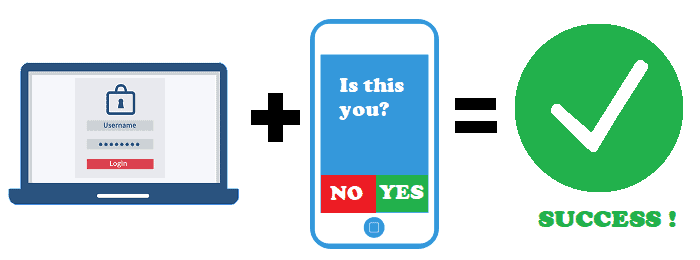Have you begun to realize that many of the accounts you’re used to easily logging into with one password now require extra steps? This is called multi-factor authentication, also commonly referred to as two-factor authentication. With the increasingly rising threats of cybercrime, multi-factor authentication has become increasingly popular in recent years as organizations look for ways to strengthen their security posture and protect against sophisticated cyber threats. To learn more about how multi-factor authentication can help protect your accounts from hackers and ransomware attacks, keep reading!
What is Multi-Factor Authentication?
Multi-Factor Authentication (MFA) is an account security measure that requires more than one form of authentication to verify the identity of a user and gain access to an application, online account, or VPN. This can mean that in addition to a password, users may also be required to input a security token such as a code that was sent to your phone or email, answer a security question, or even use biometric data such as a thumbprint or face ID. Another form of MFA is three-factor authentication, which adds an additional layer of security by requiring the use of three different factors. For example, you may be required to input your password, a code that’s been sent to your phone, and answer a security question. This single action prevents the vast majority of accounts from being compromised, even with the continued use of weak passwords. While it may sound like a hassle to have to go through extra steps to log into your accounts, multi-factor authentication provides an extra layer of security that can help protect your data from hackers and other cyber threats.
What are the Benefits of Multi-Factor Authentication?
One of the biggest benefits of multi-factor authentication is that it makes it much more difficult for attackers to successfully compromise accounts, even if they have obtained some login credentials. This is because even if an attacker has your username and password, they would still need to have access to your security token or know your biometric data in order to log in successfully.

OTHER BENEFITS:
- Improved security: By requiring users to provide more than one form of identification, multi-factor authentication can help to improve the security of your accounts and data.
- Reduced chances of account takeover: multi-factor authentication can help to reduce the chances of hackers being able to take over your account, as they would need to have access to more than just your password.
- Easier compliance with regulations: For businesses that are required to comply with regulations, multi-factor authentication can help to make compliance easier.
Are There Any Drawbacks of Multi-Factor Authentication?
As cybersecurity experts, we highly advocate for organizations and individuals to deploy multi-factor authentication across all password-protected accounts. With that said, we’ve listed the most popular drawbacks people consider when using multi-factor authentication below.
COMMON DRAWBACKS:
- Inconvenience: The extra steps involved in logging into an account can be inconvenient for users. But wouldn’t it be more inconvenient for a cyberattack to occur? If you’re hesitant to turn on MFA for this reason, BrunNet can show you ways to minimize disruption and make a smooth transition for your users. With the right access policies, you can prompt users for MFA only when necessary – for example – only when working outside of the office.
- Potential for disruptions: If a user loses their phone or doesn’t have access to the internet, they may not be able to log into their account. However, in the case of a cyberattack, disruptions can last days or weeks! There is a broad range of authentication options to fit the needs of your business and individual users.
- Cost: Implementing multi-factor authentication can cost more money than just using password protection. Conversely, security breaches can cost organizations hundreds of thousands of dollars to mitigate. Many MFA tools (such as the Microsoft Authenticator application) are actually free and BrunNet can help you cost-effectively implement them into your organization.
Overall, multi-factor authentication is a great way to improve the security of your data and accounts. While it may seem a bit inconvenient to have to go through extra steps when logging in, the added protection is well worth it and will soon become second nature in your login process. If you’re interested in enabling multi-factor authentication across your organization, BrunNet can help! Contact us today to gain protection over your business’ important data.
